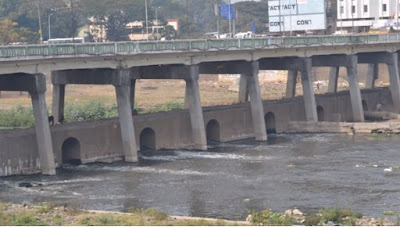Friday, April 1, 2022
River walk and Urban Sketchers
Took part in a River walk last week conducted by Jeevitnadi, and it was good that I did it.
I mean, it's been almost five decades since I have been in Pune but knew very little about the rivers of Pune. So it took some time for me to digest the fact that the river Mutha was a crore years old. Madam Shailaja (who conducted the walk) casually pointed to a rock next to the river and said that those rocks were about 6.5 crore years old, the age of Sahyadris. (Basalt formation period)
Talking about Mutha, it is supposed to be older than the rivers originating from the Himalayas, as Sahyadiri is older than the Himalaya. Another fact that I did not know was that the Mutha joins Krishna river and finally flows into the Bay of Bengal (due to the topography of India)
For those who want to know the origin, the Mutha starts from a small village named Vegare (not far from Lavasa)
While the river walk was going on, some of the members of the Urban sketchers joined in and were listening as well as sketching.
While others were sketching the Siddheshwar temple which happened to be the point of common interest for both.
Above sketch by Shirish Deshpande
Fossils of elephants and Aurochs were found on the banks of Mutha. Auroch is a type of large wild cattle (now extinct) and was the ancestor of the present domestic cattle.
The mandatory group picture
Coming back to the river walk, while we were moving around I could get a very bad stench and the water was looking really black while I tried to click some pictures of the birds.
Madam Shailaja mentioned that this river had been once rich with flora and fauna. For example, the Pied Kingfisher (कवड्या in Marathi) is known to hover over the water and with a quick dive catch its fish. But with the present state of water being murky and turbid the pied kingfisher is no longer seen on this river
The same is the case with the River Turn ( नदी सूरय in Marathi) This species has been uplisted to Near Threatened on the basis that increasing human disturbance and dam construction projects are expected to drive a moderately rapid population decline over the next three generations.
To quote one more example is the Pheasant tailed Jacana (कमलपक्षी in Marathi). They are seen on floating vegetation and the nest is usually on a leaf which floats, (mostly lotus leaf). In the absence of such vegetation, this bird is no more seen on the Mutha banks.
The River Tern creating a figure of '7' "Always a treat watching these hunt over the Panshet Dam in Pune" says Anupam who painted this.
The rivers were well taken care of during the previous era. The Kumbharves dam built during the Peshwe era marked the boundary of the then Pune. Later rebuilt by the British, it still stands under the Dengale bridge at Kumbharvada
One way to create awareness is to encourage others to attend these river walks. I have made a short one minute video of the walk I had.
There are some proposals in the pipeline, like this present state near the Shivaji bridge to be transformed into an activity area without disturbing the ecological balance.
Like the saying goes, "we have not inherited this world from our parents, we have borrowed it from our children"
..
Subscribe to:
Posts (Atom)


















